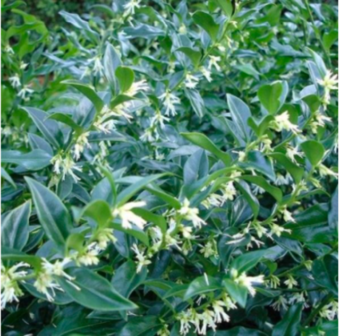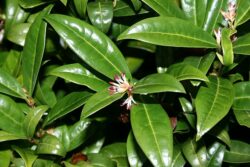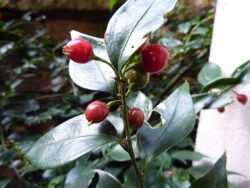In this article, we will discuss how to grow the very fragrant and delightful shrub of Sarcococca in containers. Sarcococca is a relatively small genus of 11 flowering shrubs and plants that belong to the Buxacae (the Box) family. The genus name comes from two Greek words ‘Saix’ and ‘Kakkos’ which translates as ‘Fleshy Berry’ because of the black fruits it bears after it flowers.

They are native to eastern and South –Eastern Asia, especially to the Himalayas. They are slow-growing, evergreen plants that often only grow up to 2m high. In the spring and summer months, the shrub is of little interest, as the lance-shape or oval green leaves are nothing to write home about. The leaves are borne alternately and can be 3 to 12cm long and 1 to 4cm broad.
You do not grow it for the leaves, but in late winter to early spring the plant becomes flower-arrangers favourite, as clusters of white or cream-petal male and female flowers are produced. The male flowers are more predominant and the female flowers more insignificant. Both male and female flowers are borne on the same stems, where the unforgettable, very strong fragrance is produced. The female flowers are often followed by red or black berries (depending on the variety and species grown) containing one to three seeds.
Most are low-growing and make excellent shrub species in front of container displays.
Find out how to grow Sarcococca in containers in this article.
GROWING SARCOCOCCA IN CONTAINERS
First, you will need to choose a large enough container that is well-balanced with the shrub in question. Whatever you choose make sure it has plenty of drainage holes at the bottom. To this container add a 2cm layer of gravel to help drainage even further. On top of this add multipurpose compost to within 5cm below the top rim of the container. Nothing special has to be used in terms of compost.
Dig a hole at the centre of the container slightly larger than the root ball it came in the original pot you purchased it in. Place the plant in so that the top of the root ball is at the same level as the top surface of the compost in the container. Backfill with the growing media so that no vacant space remains, using more compost if you find it necessary. Firm the plant on and water very well to allow the compost to settle down around the roots.
THE BEST GROWING CONDITIONS

If you can provide enough moisture, you can place the container in full sun. In the shade, it can take more drought. They are tough plants and can take pollution and neglect very well.
You will need to water well until the plant is well-established but after that, you will need to water when 5cm below the top surface of the compost feels dry to the touch. It is important to water when a heatwave is being forecasted. When you water do so until it emerges from the drainage holes.
As they like a humus-rich growing media, it is advised to feed every spring with a general-purpose, slow-release fertilizer to give enough nutrients to last through the growing season.
Pruning is not necessary but you can remove any damaged or unwanted branches immediately after it has finished flowering in early spring.
Propagation is via three methods- Method one, as the shrub tends to sucker freely, then you can remove them and plant them in summer. Method two is by taking semi-ripe cuttings in summer and planting them in a cold frame. Method 3 is by seeds sown in pots outdoors in autumn or spring.
PESTS AND DISEASES
The good news is that Sarcococca does not seem to suffer from many pests and diseases. They seem to be very resistant, which is brilliant.
VARIETIES TO GROW

Three species of Sarcococca are often grown in UK gardens. These include:
Sarcococca confusa has dark green, glossy leaves that look rather like a privet. The cream-coloured flowers are followed by black berries. It can grow up to 75cm tall.
The firm favourite is Sarcococca hookeriana, which is taller than S. confusa, where the leaves are narrower and have a purple tinge to them. The usual varieties are ‘Pigyma’ which grows up to 1.3m tall and ‘Winter Gem’ which grows up to 1.5m high. Two variants exist Santolina hookeriana var. humulus and Santolina hookeriana var. digyma.
A final species is Sarcococca ruscifolia which grows up to 1m tall when mature. The leaves tend to be broader and the berries tend to be red, unlike the other species mentioned above.
CONCLUSIONS
In this article, we have discussed how to grow the beautiful scented shrub of Sarcococca in containers. When not in flowers it may not look spectacular but in late winter or early spring the flowers and unforgettable scent are most definitely. They are easy to grow, easy to look after and do not suffer from pests or diseases.
You also have plenty of choices, so why not grow one today?
If you have any questions or comments that you wish to make on growing Sarcococca in containers, please do so in the comment box below.
Happy Sarcococca growing
